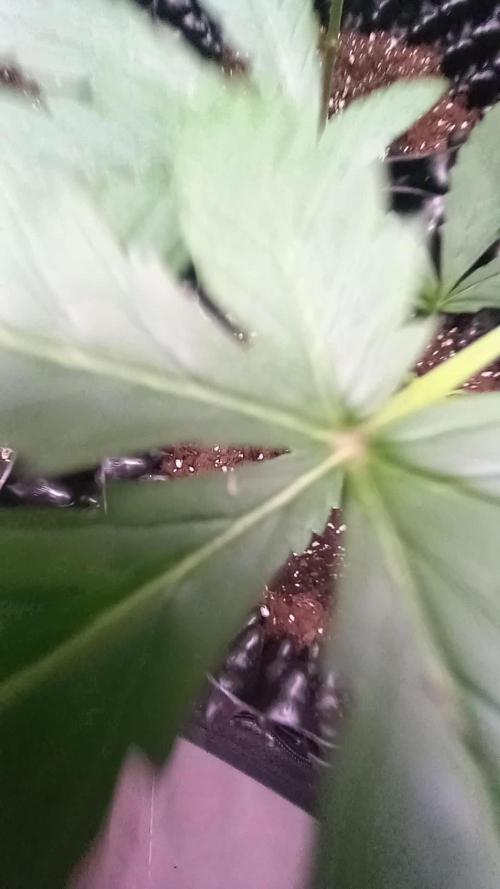The Grow Awards 2026 🏆 































Likes
Comments
Share


@Seedler
Follow
Ayyy, look at her growing! i was away for a weekend and look at this jump.
The first broken off stem attached itself after taping it. the Second branch i broke off, i tried to attach a cutting from another branch, fixated it with tape and a metal clamp. Which did not work but i think it's because i let too much green on it, so i dried up before it could fix itself. MAYBE. It's just my observation but i want to try every method i can think of, trying to attach a broken off stem again, and I will be successful finding the best technique for me. And i will share it, if i found it!
Next time i will remove almost any green so it's just a little stump, i think the shorter the cutting the better.
What do you say about the Training so far? (:
Likes
74
Share


@Hou_Stone
Follow
❄️Après 53 jours de floraison j'ai récolté 2 plantes de kong's krush qui m'ont donné 41 grammes de bourgeons sec et manucurées.
❄️Je pense que j'aurais pu ajouter + de nutriment dans mon sol et arrosé plus fréquemment pour avoir un plus gros butin, c'est prévu pour la prochaine culture !
❄️Je commence à gouter mes bourgeons qui sont encore en train de curer depuis 5 semaines.
❄️Chaque variétés ont des saveur particulière et j'ai toujours ça trouvé assez complexe de les décrire. En tout cas La saveur de la kong's krush est vraiment inédite pour moi et vraiment plaisante. Je lui trouve un petit coté pétillant,☄️
❄️
❄️Mon instagram : https://www.instagram.com/hou_stone420/
❄️
❄️Passez une bonne journée mes amis, Merci pour votre visite 🙌
☄️☄️☄️☄️☄️☄️☄️☄️☄️☄️☄️☄️☄️☄️☄️☄️
Likes
19
Share


@ThatoneAKguy
Follow
Two of the three have been cut. The first one was just a stubby little lady that had just under an ounce of dried flower. The second one was taken last night and her main cola weight 5 wet and was just covered in oily terpenes. This last one while behind the others is by FAR the frostiest and I can’t wait for her to ripen. Therefore I am not calling it a harvest until the trichomes become perfect as the last one did.
Likes
4
Share


@YSLBeezn
Follow
Sehen alle gut aus 👍🏻
Fristed guava bekommt gelbe blätter aber davon lasse ich mich erstmal nicht verunsichern.
Die Blüten wachsen ja gut👍🏻👍🏻
Processing
Likes
11
Share


@Blacksheep
Follow
WOW!!! It’s legal!!!! 50 years of hiding is over! WOW! 12 plants now, next grow 18 plants. 7 Dutch Passion Glueberrys, 2 Dutch Passion Colorado Cookies, 1 Think Different, 1 Dutch Passion Blueberry, & 1 Dinafem Sour Diesel. I have grown before inside from 1982 to 1992 - outdoors a bunch. Now I can check on my ladies everyday!
Likes
10
Share


@Juschiln420
Follow
Well it's safe to say the foop will work with legit strong good bacteria! But the focus has to be on the root health when it comes to how much food you can add and still maintain healthy roots.
But the game changer for me has been switching to a air stone, 1st and for most. The recirculation pump suggested by foop when running foop in dwc ran the solution temps into the high 70's around 77°F and anything over 75°F has been where root rot sets in for me. Even switched to way smaller recirculation pump with same results. So switching to running a air stone was big! But also found that running one Vivosun 317GPH Air Pump 15W split to 4 plants was not enough air for the roots to be happy in the foop plants. So I moved to a 2nd air pump, same size per tent. So now it's only split to 2 plants on the foop plants. And that made a big difference! But found after a few weeks that I had to bleed a slight amount of air off because there soo much extra air the humidity was sky rocketing in the tent to high 80%. So there's a sweet spot where they get extra air but not soo much that the humidity is affected.
But the 2nd most beneficial thing I've done is start running Orca. It has made such a huge difference. I think I need to go up with how much I'm using or find something that works even better if possible. But the sweet spot now is 8 to 9ml total of each foop veg/bloom 1,2 and sweener. When I go to 12ml with foop 1,2 the roots take a noticeable hit. So idk how I would go to the recommended 20 to 50ml per gallon as suggested on the foop grow chart.
Currently running around 6 to 10ml orca total per feeding. And adding 2 to 4ml when I add foop 1,2 mid week amd got happy roots!
Also the Seaweed extract has made a difference in the smell the plant puts off. Last few grows have been really muted with smells and this grow I actually get hit in the face when entering grow room. So has made a difference forsure!! I'm soo excited!!
I had skipped a feeding because I had been feeding a few tines mid week. And that's when all the yellow edges showed up I've been trying to get her back on track feeding mid week 4 to 6ml foop 1,2 and has made a difference forsure! I also added a Exhale C02 bag. So hoping that kicks her in high gear, but she already seems to be doing better! I also need to get back to trying to master the art of getting the ph to stabilize and not climb every 24hrs. Currently I have to ph daily
6/24 added 1L, 10ml Seaweed extract
6/25 added 2L
6/26 added 1.5L, 10ml Seaweed extract, 4ml orca, 4ml foop bloom 1&2, 4ml foop sweener, 3ml cal mag
6/28 added 2L
6/29 added 1.5L
6/30 added 1L, 20ml Seaweed extract
7/1 refreshed, gave 20ml hydroguard, 10ml orca, 25ml Seaweed extract, 9ml foop bloom 1&2. 10ml foop sweener, 5.5ml cal mag
Records kept here:
https://1drv.ms/x/c/fa218bbdbbfbd064/EYZwYiJbkHdKqKqmxBKBBEgBMfZ9Lh3BFPJZvpB3_52MaQ?e=v9Y0LL
👋👋👋 Hello, Thanks for checking out my grow!! Please like and follow I really appreciate it!🤟 Please feel free to leave questions and comments below!!👇 I really appreciate all advice!!! Check out my Instagram, you can message me there too! And check out my youtube for more content! Mistakes were made, but what better way then to live it and learn it yourself!!!!
Likes
24
Share


@MadeInGermany
Follow
Flowering day 57
since time change
to 12/12 h.
Hey guys :-)
The lady is slowly coming to an end 😍.
The buds start to swell extremely .
The trichomes mature day by day.
This week she was given a very light flush with Clean Fruits so that she can use up her remaining nutrients in the coming days 👍.
It will be harvested in the next 10-14 days 😍.
I can't wait to try them all :-) .
Otherwise everything was cleaned and checked.
Have fun and stay healthy 💚🙏🏻
👇🏼👇🏼👇🏼👇🏼👇🏼👇🏼👇🏼👇🏼👇🏼👇🏼👇🏼👇🏼
You can buy this Nutrients at :
https://greenbuzzliquids.com/en/shop/
With the discount code: Made_in_Germany you get a discount of 15% on all products from an order value of 100 euros.
👇🏼👇🏼👇🏼👇🏼👇🏼👇🏼👇🏼👇🏼👇🏼👇🏼👇🏼👇🏼
You can buy this strain at :
Clearwater Seeds
Water 💧 💧💧
Osmosis water mixed with normal water (24 hours stale that the chlorine evaporates) to 0.2 EC. Add Cal / Mag to 0.4 Ec Ph with Organic Ph - to 5.8 - 6.5
MadeInGermany
Likes
59
Share


@Mastr
Follow
She so bushy bud are everywhere some off them can get really light I wish I was defoilated them but it's okay I let her grow till day 90 let see the result thanks for reading and looking into this diary happy growing
I add bio heaven for bud denser recommend by grower friends 💚
Likes
18
Share


@cannasaxx
Follow
Sie haben das Umtopfen ganz gut überstanden. Eine von den dreien macht ganz gut los. Die anderen beiden haben wohl noch etwas Stress durch das Umtopfen. Alle 3 sind Samen der selben Genetik aber selbstverständlich auch verschiedene Phenotypen, sie werden auf jeden Fall unterschiedlich wachsen und aussehen. Ich finde aber No-till besser als Stecklinge und je besser der Züchter um so weniger Phenos 😉
Wir werden sehen... 😎
Processing
Likes
21
Share


@Stick
Follow
OK guys I'm back after being away for 2 weeks. I've proceeded to a final transplantation into a 9L AirPot container, right before I left for vacations. I also added a canopy-ring in order to open up the plant and start some LST without adjusting strings everyday. A friend was in charge of the grow room while I was away, and she did a pretty good job. The AK420 is healthy, she is the smallest plant in the room but her shape and color are amazing. Short inter-nodes. She has 8 main summits and all her apexes are about the same height. She will remain under vegetative stage for 1~2 weeks before flipping into 12/12 light schedule. I can't wait to see her full of buds! Thanks for stopping by 👊
Likes
111
Share


@Salokin
Follow
Hi Growmies,
Luckily she has made full recovery, in the tank below and up top :). OST of the root growth I. Observing, I would attribute to the combination of orca, rhizotonic and cannazym. Mainly the orca though ;). I will minimum give her 1–2 more weeks max until I flip her, as it feels like she should have a fairly short flowering phase. Overall she is looking very lush and healthy again, but still has some catching up to do.
Here is the code that’ll give you 20% in Zamnesia‘s online store, just input ZAMMIGD2023 at checkout.
Thanks for stepping by and until next week!
Processing
Likes
4
Share


@fezzollas
Follow
That was the most difficult week. It was very cold and rainy, the humidity of the air reached 90% at most, but without sequels, thank God. On day 63, I defoliated and she is strong, fat and definitely smells like cheese.
Likes
300
Share


@Ju_Bps
Follow
Hello growmies 👩🌾👨🌾🌲🌲,
👋 Girls are happy and doing a big stretch, hedgehogs are arrived 🦔🦔
💪 Continuing Defoliation, scrog and fight with leaves.
💧 Give water each 2/3 day
And vaporise plant with water + Plagron Roots (1ml/l)
2 l Water + Roots + Bloom + Zym + Sugar Royal (1 + 3 + 1 + 1 ml/l)
PH @6
💡Mars Hydro - FC 3000
50% 38 cm
Mars Hydro Fan kit
Setting 6
Have a good week and see you next week 👋
Thanks community for follow, likes, comments, always a pleasure 👩🌾👨🌾❤️🌲
Mars Hydro - Smart FC3000 300W Samsung LM301B LED Grow Light💡💡
https://www.mars-hydro.com/fc-3000-samsung-lm301b-led-grow-light
Mars Hydro - 6 Inch Inline Fan And Carbon Filter Combo With Thermostat Controller 💨💨
https://www.mars-hydro.com/6-inch-inline-duct-fan-and-carbon-filter-combo-with-thermostat-controller
Fast Buds - Tropicana Cookies FF🌲🌲
https://2fast4buds.com/us/seeds/tropicana-cookies-fast-flowering
Likes
8
Share


@ZanderZone777
Follow
It's week 9 of flower and she's been fed her last bit of nutrients. I'll start flushing with BushDoctor's SledgeHammer 2 tsp a gallon. Then just straight water until the chop :)
Likes
2
Share


@MrDoubleHaze
Follow
Strain Links Oben : Super Lemon Haze
Strain Oben Rechts : Break Pad Breath
Strain Mitte : Auto SFV OG
Strain Unten Links : Lemon Orange
Strain Unter Rechts : Velvet Moon
Likes
60
Share


@julian100614
Follow
Seguimos las semanas creciendo con mucha fuerza, para la semana que viene meterla a floracion y que empiece a crear buenos frutos 💪
Hemos aplicado canna zym para una mejor absorción de todos los nutrientes y la semana que viene empezaremos a cambiar su comida para que cree esos cogollos grandes 🔥

























